Intel Core i9-10850K Review: The Real Intel Flagship
by Dr. Ian Cutress on January 4, 2021 9:00 AM EST- Posted in
- CPUs
- Intel
- Core
- Z490
- 10th Gen Core
- Comet Lake
- LGA1200
- i9-10850K
CPU Tests: Encoding
One of the interesting elements on modern processors is encoding performance. This covers two main areas: encryption/decryption for secure data transfer, and video transcoding from one video format to another.
In the encrypt/decrypt scenario, how data is transferred and by what mechanism is pertinent to on-the-fly encryption of sensitive data - a process by which more modern devices are leaning to for software security.
Video transcoding as a tool to adjust the quality, file size and resolution of a video file has boomed in recent years, such as providing the optimum video for devices before consumption, or for game streamers who are wanting to upload the output from their video camera in real-time. As we move into live 3D video, this task will only get more strenuous, and it turns out that the performance of certain algorithms is a function of the input/output of the content.
HandBrake 1.32: Link
Video transcoding (both encode and decode) is a hot topic in performance metrics as more and more content is being created. First consideration is the standard in which the video is encoded, which can be lossless or lossy, trade performance for file-size, trade quality for file-size, or all of the above can increase encoding rates to help accelerate decoding rates. Alongside Google's favorite codecs, VP9 and AV1, there are others that are prominent: H264, the older codec, is practically everywhere and is designed to be optimized for 1080p video, and HEVC (or H.265) that is aimed to provide the same quality as H264 but at a lower file-size (or better quality for the same size). HEVC is important as 4K is streamed over the air, meaning less bits need to be transferred for the same quality content. There are other codecs coming to market designed for specific use cases all the time.
Handbrake is a favored tool for transcoding, with the later versions using copious amounts of newer APIs to take advantage of co-processors, like GPUs. It is available on Windows via an interface or can be accessed through the command-line, with the latter making our testing easier, with a redirection operator for the console output.
We take the compiled version of this 16-minute YouTube video about Russian CPUs at 1080p30 h264 and convert into three different files: (1) 480p30 ‘Discord’, (2) 720p30 ‘YouTube’, and (3) 4K60 HEVC.
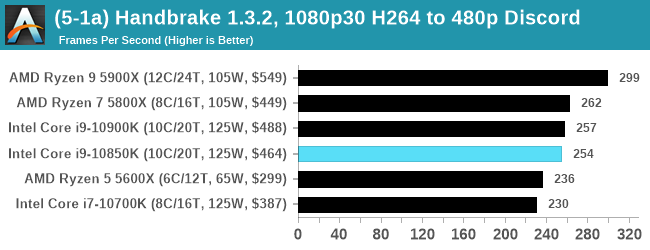
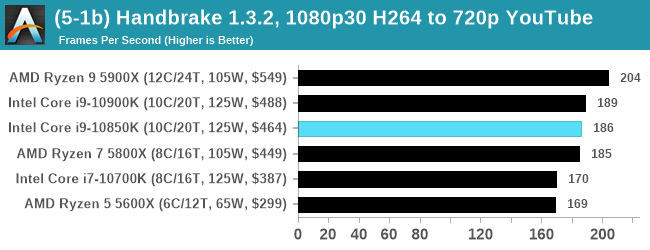
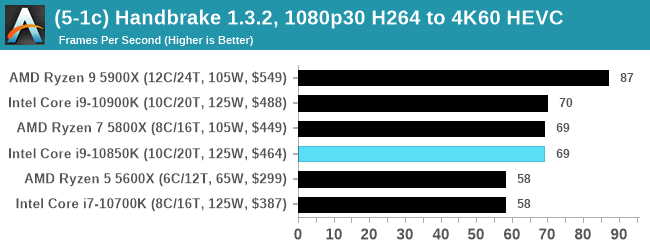
7-Zip 1900: Link
The first compression benchmark tool we use is the open-source 7-zip, which typically offers good scaling across multiple cores. 7-zip is the compression tool most cited by readers as one they would rather see benchmarks on, and the program includes a built-in benchmark tool for both compression and decompression.
The tool can either be run from inside the software or through the command line. We take the latter route as it is easier to automate, obtain results, and put through our process. The command line flags available offer an option for repeated runs, and the output provides the average automatically through the console. We direct this output into a text file and regex the required values for compression, decompression, and a combined score.
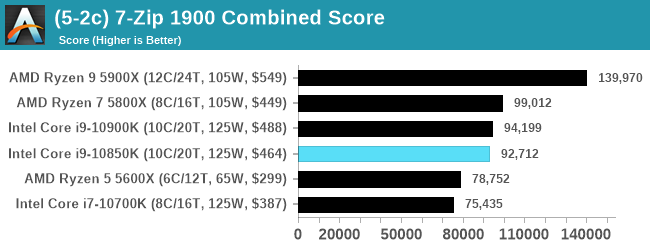
AES Encoding
Algorithms using AES coding have spread far and wide as a ubiquitous tool for encryption. Again, this is another CPU limited test, and modern CPUs have special AES pathways to accelerate their performance. We often see scaling in both frequency and cores with this benchmark. We use the latest version of TrueCrypt and run its benchmark mode over 1GB of in-DRAM data. Results shown are the GB/s average of encryption and decryption.
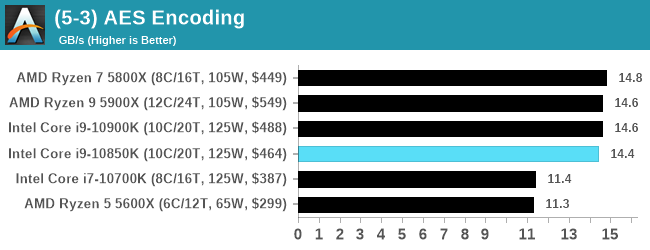
WinRAR 5.90: Link
For the 2020 test suite, we move to the latest version of WinRAR in our compression test. WinRAR in some quarters is more user friendly that 7-Zip, hence its inclusion. Rather than use a benchmark mode as we did with 7-Zip, here we take a set of files representative of a generic stack
- 33 video files , each 30 seconds, in 1.37 GB,
- 2834 smaller website files in 370 folders in 150 MB,
- 100 Beat Saber music tracks and input files, for 451 MB
This is a mixture of compressible and incompressible formats. The results shown are the time taken to encode the file. Due to DRAM caching, we run the test for 20 minutes times and take the average of the last five runs when the benchmark is in a steady state.
For automation, we use AHK’s internal timing tools from initiating the workload until the window closes signifying the end. This means the results are contained within AHK, with an average of the last 5 results being easy enough to calculate.
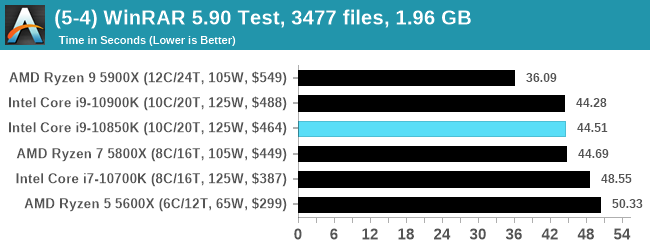


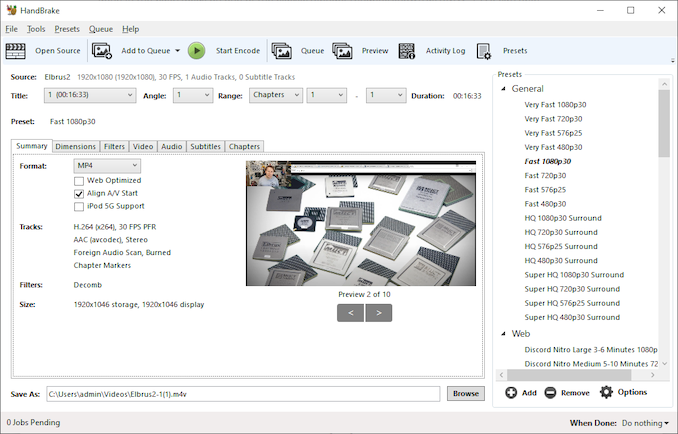
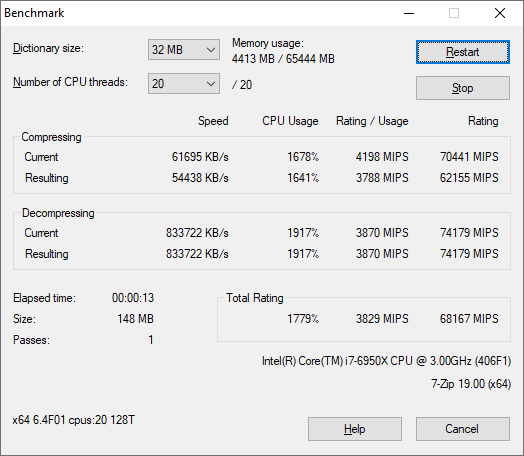









126 Comments
View All Comments
1_rick - Monday, January 4, 2021 - link
Because you've got the people who will spend any amount of money to get 5fps more in their games so they can smugly tell everyone who they've got the best.lopri - Monday, January 4, 2021 - link
I see Ryzens beating this thing by sizeable margins in games.zodiacfml - Monday, January 4, 2021 - link
Ryzen 5000 series is significantly faster than Intel's i9-10900k in all games though I haven't seen compared with overclocks. The Intel gets good at rendering/encode but I'd rather buy old Xeons with Chinese motherboards for those loadsV3ctorPT - Monday, January 4, 2021 - link
In gaming the real star is the 5600X... awesome performance for its price, for a 65W(!) CPU...lmcd - Monday, January 4, 2021 - link
It's basically an 80W CPU though lolCrazyeyeskillah - Monday, January 4, 2021 - link
my 5600x is 10-20c hotter than my 3600 clock for clock on the same exact rig and watercooler.JessNarmo - Monday, January 4, 2021 - link
I was considering 10850k as an upgrade option when I it for $400. It's undeniably significantly better deal than 10900k at $530.But ultimately decided that it's just not good enough for an upgrade because it still doesn't support PCIE 4 so if I upgrade I would have to upgrade again very shortly.
Would have to wait for 5900x availability or maybe intel will come up with something better.
edzieba - Monday, January 4, 2021 - link
The same argument can be made for the 5900x and PCIe 5 (or DDR 5). There will always be a new protocol, or new interface, or etc on the horizon.JessNarmo - Monday, January 4, 2021 - link
Disagree. Right now I have the same Skylake cores running 5Ghz and the same PCIE 3, the same everything and it's still fine except I have less cores.With 5900x I'll get better single thread and multi thread performance as well as PCIE4 which is really important for future GPU's and upcoming upgrades unlike PCIE5 which isn't important at all at this point in time.
MDD1963 - Monday, January 4, 2021 - link
PCI-e 4.0 was going to be 'critical' for GPUs to get best performance from a 3080/3090...; instead, it was/is still a non-player. Maybe that will change for next gen. Maybe not.